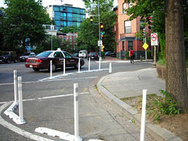Cheh wants to restore “professionalism” in traffic calming
DC Councilmember Mary Cheh yesterday introduced a bill to require DDOT to conduct a formal analysis of traffic patterns before installing speed bumps or other “high-impact” traffic calming measures. The bill would essentially require DDOT to return to a previous policy, similar to their procedures on other traffic changes like rush-hour parking restrictions. It also pushes back against increasingly frequent political meddling in DDOT decisions.
If residents want, for example, to change a rush-hour no-parking lane into a parking-always lane to slow traffic on a street, DDOT requires an endorsement by the ANC and a traffic analysis. But after Mayor Fenty took office, DDOT changed its policy on speed bumps to allow any block to request them — as long as that street is not a “collector” or “arterial” road. In places like Chevy Chase, that’s triggered animosity between blocks, as residents of some blocks tried to prevent others from getting humps which would divert traffic onto their blocks.
A street grid is valuable because it spreads traffic among many parallel roads, instead of forcing it all into a single traffic sewer. When blocks start competing to drive traffic away, it gradually makes the neighborhood more like a cul-de-sac subdivision with choked main roads and few choices. Cheh’s bill aims to reverse this trend.
The bill requires DDOT to conduct an “analysis” at least 30 days before installing or removing any “high-impact” traffic calming measure. High-impact measures are those “that significantly divert, reduce, or otherwise affect traffic volume or speeds or the availability emergency services, including full-street closures, median barriers, raised crosswalks, raised intersections, speed bumps, speed humps, and speed tables.”
The term “high-impact” seems written to exclude certain types of pedestrian safety improvements, like bulb-outs, which also often fall into the category of traffic calming. Do improvements such as those at 15th and W count as “high-impact”? Perhaps not, but if they are, DDOT would only need to conduct an analysis first. The criteria for the analysis, such as “operational conditions within a traffic stream,” ought to also include the impact on pedestrian and bicycle safety of the traffic calming measure. If a measure affects buses, that should also go into the analysis; too often DOTs make traffic decisions based on total vehicle volume instead of considering the value of moving a bus containing 30 people.
DDOT must post the analysis online, and notify the ANC with 30 days’ notice. I’d suggest requiring the report to go online 30 days ahead as well.
It’s important for DDOT to be able to try out improvements, including speed bumps or anything else. Doing that isn’t a political decision, but a smart professional one, to collect real data on whether an improvement is right. That’s why it’s good to see this bill leave an exception for “experimental traffic calming measures.” DDOT can put them in without an analysis, as long as they remove (or, presumably, conduct the analysis) within 180 days if the ANC doesn’t support the change.
Really, however, this ought not be necessary. DDOT should base all of its decisions on professionalism, not on political factors or neighborhood whim. Recently, there’s been a spate of evident mayoral meddling in transportation, from speed bumps to sidewalks. Even the decision to keep the Circulator on Wisconsin Avenue was clearly political. DDOT determined that it wasn’t cost-effective. I’m all for more transit and more money for transit, and it’s good that the Mayor heard loud voices in support of transit, but if this recommended closure had hit another neighborhood less organized than Georgetown, it’s likely the cut would have gone through.
The proper place for politics is in setting broad policies, not deciding items on a case by case basis. DC could use a transportation plan that sets out priorities, such as pedestrian safety and transit. The sidewalk assurance bill is a good example. Policies can be political. Then, DDOT needs the freedom to implement the general policies professionally, taking the specifics of a neighborhood into account but not the closeness of certain residents to the Mayor.


